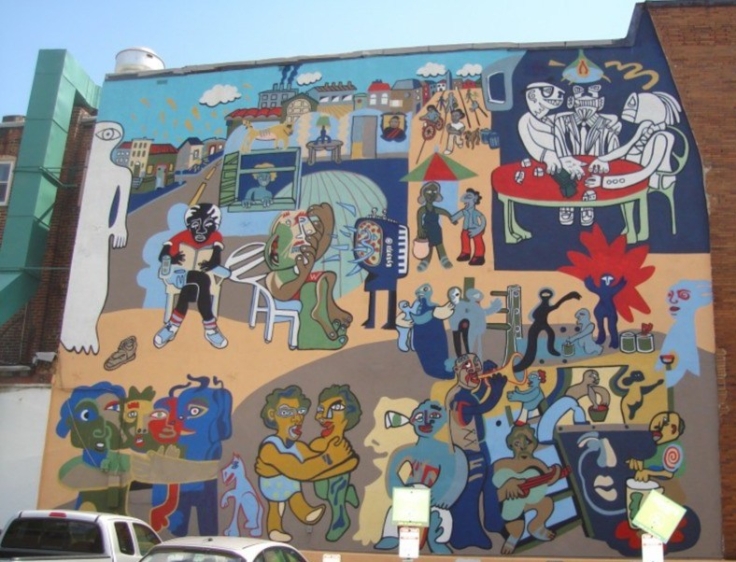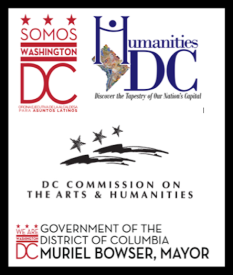Just a few decades ago, a resident of Adams Morgan could take a walk around the neighborhood, shop for Latin American music at Zodiac Records; find everything needed to make pupusas at El Gavilan Grocery; or catch a Mexican movie at The Ontario Theatre. Each of these establishments and many others served as popular gathering places for Latino residents.
In the 1980s, the neighborhood was easily identifiable by its large Latino population and the businesses that catered to their needs. Today, the neighborhood is flooded with new businesses and condominiums, which cater to the population that has largely turned white–68.6 percent white according to U.S. Census data.
The term “gentrification” was originally used as a word to describe the process of resettlement by people of a higher socioeconomic status into working-class areas which had become fashionable and expensive. Now, the term connotes a more negative process due, in part, to its often harsh treatment of lower-income residents, particularly people of color and immigrants.
According to Nancy Mirabal, an associate professor at University of Maryland’s American Studies Department, gentrification impacts the community in three main ways: economically, culturally, and emotionally.
The process of gentrification has occurred in Washington, D.C., for many decades. Its deep and complicated history can make its roots difficult to identify and prove that the problem exists to those who are oblivious to it. Consequently, some of the earliest instances of gentrification are absent from history books which can blind people about the discrimination occurring in their own communities and neighborhoods, according to Jeffrey Henig, in the book, “Gentrification in Adams Morgan: Political and Commercial Consequences of Neighborhood Change,” published in 1982.
In the 1980s, Latino immigrants arrived in the D.C. area in great numbers, many of them settling in Adams Morgan and other neighborhoods, where they had family or knew people from their homelands. Latin American refugees back in the ’80s were also attracted to the organizations that provided services to the burgeoning Latino community, such as the Latin American Youth Center (LAYC) and the Central American Resource Center (CARECEN).
Alicia Wilson, the executive director of La Clínica del Pueblo, explains that the people are “serving and where [they’re] serving them has changed dramatically because this neighborhood is not the epicenter of the Latino community that it once was” back in 1983, when the health center that first opened its doors.
“In the ’80s this was the barrio and now it’s gentrified land, where it’s inaccessible, except for in certain rent-controlled spaces,” Wilson says. As the neighborhood has changed, Wilson says it is increasingly difficult to find Latinos in close proximity.
The Founder and CEO of Mary’s Center, Maria Gomez, explains the loss of the Latino community as a chain reaction, with rising real estate prices as the catalyst.
“[P]eople have lost their housing,” she says. “And when they lose their housing they also lose schooling, and they lose schooling they also lose all their social connections because a lot of their social connections come from their kids’ school, or from church and those things aren’t there anymore.”
While there’s a lot of emotion over how rising housing costs have forced longtime residents out, some believe that alongside gentrification has come an increase in the number of resources, like schools. Lori Kaplan, for instance, the former president and CEO of the Latin American Youth Center, who just stepped down in June 2018 after 39 years, told us: “There have been changes. And a lot of things have gotten better.”
“I mean, look at the opportunities at the schools nowadays,” she adds. “It’s crazy, you’ve got Bell (Multicultural High School), you’ve got Wilson (High School), you’ve got all these other ones that offer bilingual opportunity.”
Others see the changes in a negative light. Guillermo Fajardo, my father and community member of more than thirty years, sees what he calls “a hybrid change.” To him, there’s too much money for just a few people. There are beautiful murals in Adams Morgan, done by intellectual people, that symbolize the multiculturalism of the neighborhood. Community members tried to preserve this diversity, he says, until the people with money came in.
Various perspectives and opinions exist concerning gentrification, but what is undeniable is that it comes unannounced as the result of unpredictable private market decisions over time, usually displacing longtime community members. Experiencing the loss of your home can be traumatic, which typically impacts older and less affluent people.
One longtime resident Hola Cultura interviewed said today the city focuses less on art and more on real estate, which was also a common trend in many interviews conducted with older community members. This is apparent in Adams Morgan by the influx of new luxury apartments and businesses, and the destruction of murals significant to the Latino community.
According to experts, gentrification also erases stories and experiences of different groups of people. Residents are forced to question the impact of these changes on life in their neighborhood. Hola Cultura is looking to salvage and preserve this precious history by documenting the story of Latinos in Adams Morgan who have all been affected by gentrification.
The process of gentrification is both conscious and unconscious, usually in that order. In Adams Morgan, “instead of using coercive tactics, [developers] bought people out. You have to remember when you have community members living below the poverty line, and someone comes offering you fifty, sixty, seventy thousand dollars to get your right to buy out, you’ll take it, says Abel Núñez, Executive Director of CARECEN.
The unconscious part, he adds, is that “D.C. is very progressive. We have to be clear that it’s progressives who are displacing people, not big, bad rich people.
“It’s easy to say ‘the gentrifier.’ Let’s ask who the gentrifiers are. Most of them are young professionals, very progressive,” Núñez says. “They want to go to their bars, they want to go to their cafes. Most of the young, white professionals that come here don’t mix with the existing community. They slowly begin to push people out.”
Superficially, gentrification may seem desirable (especially to prospective residents), and is often mislabeled as “revitalization,” but upon closer examination, all that has been left behind becomes apparent. El Gavilan is a beloved Adams Morgan business and a rare case of survival despite rising rent and lack of patronage. The Ontario Theatre and Zodiac Records did not fare as well. Both permanently closed decades ago. The Ontario today is a luxury condominium building, while a nail spa is housed in the former Zodiac locale today.
The Line hotel has recently moved into a 110-year-old historic church behind Unity Park. Both the park and the hotel provide examples of “battleground” between different cultural values and economic interests. The park had a Friday food market reminiscent of the street food you’d find in Latin America. It closed in 2010 after complaints from restaurant owners in the neighborhood. The Line has also been a controversial subject of many neighborhood discussions, as some feel it has contributed to gentrification and rising real estate prices in Adams Morgan. Others see tourism as a positive change.

Adams Morgan has undergone a myriad of economic and cultural shifts in its time. In the early 1980s, to many outsiders, Adams Morgan could be distinguished by its large Hispanic population, which started to become more visible in the 1940s and 1950s, when a small network of Latino-run businesses began appearing in the neighborhood.
A map showing the 1980 census tracts for Adams Morgan estimated 2,014 people of Latino origin, which was about 13% of the population, a 14% increase since the previous Decennial Census of 1970, according to Henig. However, experts at the Brookings Institute and elsewhere say that Latinos are routinely undercounted by the Census Bureau, many of whom are immigrants and may not want to be counted, since they may see it as a threat to their ability to remain in the U.S. This make it difficult to determine an accurate number of Latinos in the country and how their population size has changed over time.
Gentrification is a complex problem that can often be invisible to people, which leads to denial of its existence and perpetuates the problems it creates. Professor Mirabal gave Hola Cultura summer interns tips on how to identify a gentrifying neighborhood. She recommends exploring businesses, new and old, and what brought them to or allowed them to stay in the neighborhood.
New cafes, restaurants, luxury apartments, hospitals, expanded public transportation, and charter schools can all be signs that an area has changed or been gentrified. The presence of charter schools are especially seen as markers of gentrification, experts say, as public schools are an essential resource to low-income families, and charter schools drain money from them with a more “elite” demographic of students coming from affluent families that prefer charter over public.
When the Metro station and other services opened up in Columbia Heights in 1999, economic development accelerated. Those who were more affluent, including corporations, could develop an area faster than people who are not as well off. Organizations like CARECEN made small dents in the fight to keep the area safe from ruthless developers, winning several buildings, according to its CEO.
Unfortunately, the tactic of buying low-income residents out of their homes was just one of several methods developers soon discovered to displace them and turn their homes into attractive condos. Residents who lived here in the late ’70s fondly remember affordable housing and take credit for the early economic development of Adams Morgan and surrounding Latino neighborhoods that set neighborhood gentrification into motion.
This issue not only affects D.C.’s Latino community. Gentrification is occurring (even as you read this!) in many parts of the U.S., and across the globe. Opponents of gentrification find solidarity in banding together with the remaining community members and establishments. Some have even taken steps to fight developers and local government.
Gentrification has become such a prevalent matter of concern locally that civil rights attorney, Aristotle Theresa recently sued the D.C. government for gentrification by. On behalf of a few African-American residents, Theresa argues that D.C. policies and efforts regarding “mixed-income housing” are classist, racist and ageist” and “lead to widespread gentrification and displacement.” Theresa has argued a total of fourteen cases to the D.C. Court of Appeals so far, winning only two.
Today, Adams Morgan is nearly unrecognizable from what it once looked like. With very few Latino-oriented establishments remaining, rising rent, and new businesses and housing that caters to a different demographic, Latinos have largely left. Thanks to gentrification, Adams Morgan is no longer a welcoming home for anyone who isn’t a “young, white professional.”
—Isabel Fajardo



Leave a comment